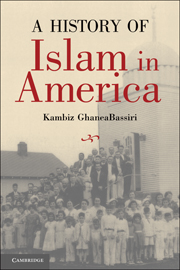21 results
Leila Ahmed . A Quiet Revolution: The Veil's Resurgence, from the Middle East to America. New Haven and London: Yale University Press, 2011. vii + 352 pages, introduction, acknowledgements, notes, index. Cloth US$30.00 ISBN 978-0-300-17095-5; Paper US$22.00 978-0-399-18143-2.
-
- Journal:
- Review of Middle East Studies / Volume 49 / Issue 2 / August 2015
- Published online by Cambridge University Press:
- 18 May 2016, pp. 178-180
- Print publication:
- August 2015
-
- Article
- Export citation
Notes on Contributors
-
-
- Book:
- The Cambridge Companion to American Islam
- Published online:
- 05 August 2013
- Print publication:
- 12 August 2013, pp xi-xvi
-
- Chapter
- Export citation
12 - Religious Normativity and Praxis among American Muslims
-
-
- Book:
- The Cambridge Companion to American Islam
- Published online:
- 05 August 2013
- Print publication:
- 12 August 2013, pp 208-227
-
- Chapter
- Export citation
List of Illustrations
-
- Book:
- A History of Islam in America
- Published online:
- 05 August 2012
- Print publication:
- 19 April 2010, pp vii-viii
-
- Chapter
- Export citation
3 - Conflating Race, Religion, and Progress
-
- Book:
- A History of Islam in America
- Published online:
- 05 August 2012
- Print publication:
- 19 April 2010, pp 95-134
-
- Chapter
- Export citation
1 - Islam in the “New World”
-
- Book:
- A History of Islam in America
- Published online:
- 05 August 2012
- Print publication:
- 19 April 2010, pp 9-58
-
- Chapter
- Export citation
Frontmatter
-
- Book:
- A History of Islam in America
- Published online:
- 05 August 2012
- Print publication:
- 19 April 2010, pp i-iv
-
- Chapter
- Export citation
7 - A New Religious America and a Post-Colonial Muslim World
-
- Book:
- A History of Islam in America
- Published online:
- 05 August 2012
- Print publication:
- 19 April 2010, pp 272-326
-
- Chapter
- Export citation
6 - Islam and American Civil Religion in the Aftermath of World War II
-
- Book:
- A History of Islam in America
- Published online:
- 05 August 2012
- Print publication:
- 19 April 2010, pp 228-271
-
- Chapter
- Export citation
Introduction
-
- Book:
- A History of Islam in America
- Published online:
- 05 August 2012
- Print publication:
- 19 April 2010, pp 1-8
-
- Chapter
- Export citation
Acknowledgments
-
- Book:
- A History of Islam in America
- Published online:
- 05 August 2012
- Print publication:
- 19 April 2010, pp ix-x
-
- Chapter
- Export citation
Index
-
- Book:
- A History of Islam in America
- Published online:
- 05 August 2012
- Print publication:
- 19 April 2010, pp 427-446
-
- Chapter
- Export citation
Epilogue
-
- Book:
- A History of Islam in America
- Published online:
- 05 August 2012
- Print publication:
- 19 April 2010, pp 379-382
-
- Chapter
- Export citation
Contents
-
- Book:
- A History of Islam in America
- Published online:
- 05 August 2012
- Print publication:
- 19 April 2010, pp v-vi
-
- Chapter
- Export citation

A History of Islam in America
- From the New World to the New World Order
-
- Published online:
- 05 August 2012
- Print publication:
- 19 April 2010
2 - Islamic Beliefs and Practice in Colonial and Antebellum America
-
- Book:
- A History of Islam in America
- Published online:
- 05 August 2012
- Print publication:
- 19 April 2010, pp 59-94
-
- Chapter
- Export citation
Select Bibliography
-
- Book:
- A History of Islam in America
- Published online:
- 05 August 2012
- Print publication:
- 19 April 2010, pp 383-426
-
- Chapter
- Export citation
8 - Between Experience and Politics
-
- Book:
- A History of Islam in America
- Published online:
- 05 August 2012
- Print publication:
- 19 April 2010, pp 327-378
-
- Chapter
- Export citation
4 - Race, Ethnicity, Religion, and Citizenship
-
- Book:
- A History of Islam in America
- Published online:
- 05 August 2012
- Print publication:
- 19 April 2010, pp 135-164
-
- Chapter
- Export citation
5 - Rooting Islam in America
-
- Book:
- A History of Islam in America
- Published online:
- 05 August 2012
- Print publication:
- 19 April 2010, pp 165-227
-
- Chapter
- Export citation



